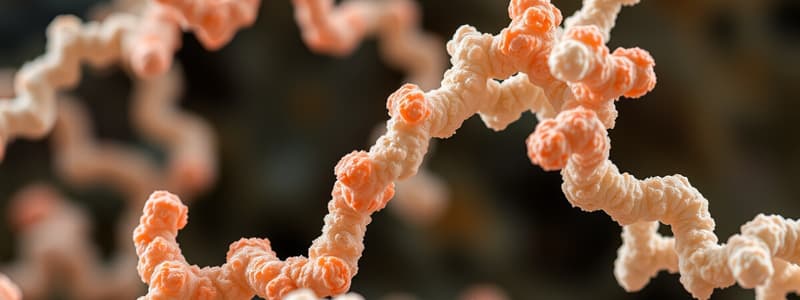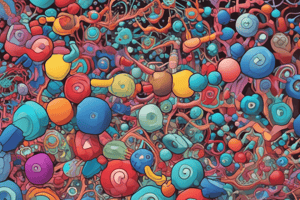Podcast
Questions and Answers
What is a significant characteristic of dense irregular connective tissue?
What is a significant characteristic of dense irregular connective tissue?
- Single orientation of cells
- Predominance of reticular fibers
- High flexibility with less resistance
- Clear predominance of collagen fibers (correct)
What type of cells are most commonly found in elastic tissue?
What type of cells are most commonly found in elastic tissue?
- Adipocytes
- Fibroblasts (correct)
- Chondrocytes
- Macrophages
Which of the following is NOT true about elastic tissue?
Which of the following is NOT true about elastic tissue?
- Surrounded by a small amount of loose connective tissue
- Less flexible and resistant to stress
- Is more flexible than dense irregular connective tissue (correct)
- Contains thick, parallel elastic fibers
Where can dense irregular connective tissue be commonly found?
Where can dense irregular connective tissue be commonly found?
Which of the following best describes the orientation of fibers in dense irregular connective tissue?
Which of the following best describes the orientation of fibers in dense irregular connective tissue?
What is the primary function of mast cells within connective tissue?
What is the primary function of mast cells within connective tissue?
Which type of connective tissue is characterized by a more abundant distribution and fills spaces between fibers?
Which type of connective tissue is characterized by a more abundant distribution and fills spaces between fibers?
What distinguishes mucosal mast cells from connective tissue mast cells?
What distinguishes mucosal mast cells from connective tissue mast cells?
What type of cell is primarily responsible for synthesizing antibodies in connective tissue?
What type of cell is primarily responsible for synthesizing antibodies in connective tissue?
How do adipose cells contribute to body temperature regulation?
How do adipose cells contribute to body temperature regulation?
Which characteristic of a plasma cell's nucleus is notable?
Which characteristic of a plasma cell's nucleus is notable?
What determines the specific type or characteristic of connective tissue?
What determines the specific type or characteristic of connective tissue?
Which of the following best describes the cytoplasm of mast cells?
Which of the following best describes the cytoplasm of mast cells?
Which of the following correctly describes glycosaminoglycans?
Which of the following correctly describes glycosaminoglycans?
What role do glycosaminoglycans play in the body?
What role do glycosaminoglycans play in the body?
What is the molecular weight characteristic of heparan sulfate found in glycosaminoglycans?
What is the molecular weight characteristic of heparan sulfate found in glycosaminoglycans?
How do proteoglycans interact with collagen?
How do proteoglycans interact with collagen?
What describes the carbohydrate portion of proteoglycans?
What describes the carbohydrate portion of proteoglycans?
Which process initiates glycosylation of the proteoglycan's protein moiety?
Which process initiates glycosylation of the proteoglycan's protein moiety?
What is one of the main biological functions of glycosaminoglycans in the immune system?
What is one of the main biological functions of glycosaminoglycans in the immune system?
Which statement accurately describes the relationship between glycosaminoglycans and nutrition?
Which statement accurately describes the relationship between glycosaminoglycans and nutrition?
What type of cells produce components involved in inflammation related to glycosaminoglycans?
What type of cells produce components involved in inflammation related to glycosaminoglycans?
How do glycosaminoglycans contribute to the mechanical properties of connective tissues?
How do glycosaminoglycans contribute to the mechanical properties of connective tissues?
Which component is found in the extracellular matrix (ECM) but not in the ground substance?
Which component is found in the extracellular matrix (ECM) but not in the ground substance?
Which cells in loose connective tissue are characterized by secretory granules and stain with metachromasia?
Which cells in loose connective tissue are characterized by secretory granules and stain with metachromasia?
What is the most likely target of peptide-based drugs that disrupt tumor cell adhesion to the ECM?
What is the most likely target of peptide-based drugs that disrupt tumor cell adhesion to the ECM?
Which glycosaminoglycan is best known for retaining water within the ground substance?
Which glycosaminoglycan is best known for retaining water within the ground substance?
Which connective tissue component primarily contributes to the tensile strength of tissues?
Which connective tissue component primarily contributes to the tensile strength of tissues?
Which of the following statements regarding proteoglycans is accurate?
Which of the following statements regarding proteoglycans is accurate?
Which component is a key factor in the adhesion of cells to the extracellular matrix?
Which component is a key factor in the adhesion of cells to the extracellular matrix?
Which type of collagen is primarily found in reticular fibers?
Which type of collagen is primarily found in reticular fibers?
What primary role do reticular cells serve in connective tissue?
What primary role do reticular cells serve in connective tissue?
Which substance predominantly composes the ground substance of mucous tissue?
Which substance predominantly composes the ground substance of mucous tissue?
In which areas of the body are reticular cells primarily found?
In which areas of the body are reticular cells primarily found?
What characterizes the consistency of mucous tissue?
What characterizes the consistency of mucous tissue?
What is a defining feature of the architecture of reticular tissue?
What is a defining feature of the architecture of reticular tissue?
What happens to the ground substance during the preparation of connective tissue samples?
What happens to the ground substance during the preparation of connective tissue samples?
What type of cells are primarily involved in the production of reticular fibers?
What type of cells are primarily involved in the production of reticular fibers?
How is the ground substance of connective tissue generally described when viewed under a microscope?
How is the ground substance of connective tissue generally described when viewed under a microscope?
Flashcards are hidden until you start studying
Study Notes
Glycosaminoglycans (GAGs)
- Composed of linear polysaccharides, consisting of repeating disaccharide units.
- Include uronic acid (glucuronic or iduronic acid) and hexosamine (glucosamine or galactosamine).
- Major representative: Heparan sulfate, known for its high molecular weight (hundreds to thousands of kDa) and intense hydrophilicity.
- Provide structural integrity, encapsulating organs and forming tissue frameworks (e.g., tendons, ligaments).
Functions of Glycosaminoglycans
- Structural Support: Encapsulates and maintains organ integrity, particularly in specialized tissues like bone and cartilage.
- Defense Mechanism: Contributes to immune response via phagocytic cells and provides barriers against bacteria dispersion.
- Nutritional Role: Facilitates waste and nutrient exchange between blood vessels and surrounding tissues, very crucial for epithelial layers.
Proteoglycans
- Comprise a protein core with covalently attached GAGs, which make up 80-90% of their weight.
- Synthesis starts in the rough endoplasmic reticulum (RER), with glycosylation and sulfation processes occurring in the Golgi complex.
- Exhibit strong binding to collagen through electrostatic interactions due to their negatively charged groups.
Mast Cells
- Characterized as oval to round connective tissue cells (20-30 µm) filled with basophilic granules.
- Release leukotrienes and have two main populations: connective tissue mast cells (heparin proteoglycan) and mucosal mast cells (chondroitin sulfate proteoglycan).
- Possess specific receptors for IgE, playing a role in allergic responses.
Plasma Cells
- Large ovoid cells, abundant in rough endoplasmic reticulum, tasked with antibody production.
- Exhibit an eccentrically placed nucleus with compact heterochromatin.
Adipose Cells
- Specialize in fat storage and thermoregulation, aiding in maintaining body temperature.
- Connective tissue characteristics depend on the types of cells, fibers, and ground substance present.
Types of Connective Tissues
- Connective Tissue Proper:
- Loose Connective Tissue: Includes areolar tissue, supports organs and fills spaces.
- Dense Connective Tissue: Contains a predominance of collagen fibers, few cells, and greater resistance to stress.
- Variations include dense irregular tissue with no specific orientation.
Specialized Connective Tissues
- Elastic Tissue: Comprised of thick, parallel elastic fibers found in structures like ligaments.
- Reticular Tissue: A loose connective tissue variant that forms structural frameworks for blood cell formation sites like lymphoid organs.
- Mucous Tissue: Rich in amorphous ground substance primarily made of hyaluronic acid; found in umbilical cord and young tooth pulp.
Key Observations
- Ground substance appears as a hydrated space under the microscope, as it dehydrates during preparation.
- Proteoglycan interactions with collagen are crucial for tissue stability and resilience.
Types of Collagen
- Collagen classification is based on distinct structural differences, essential for understanding connective tissue mechanics.
Studying That Suits You
Use AI to generate personalized quizzes and flashcards to suit your learning preferences.




